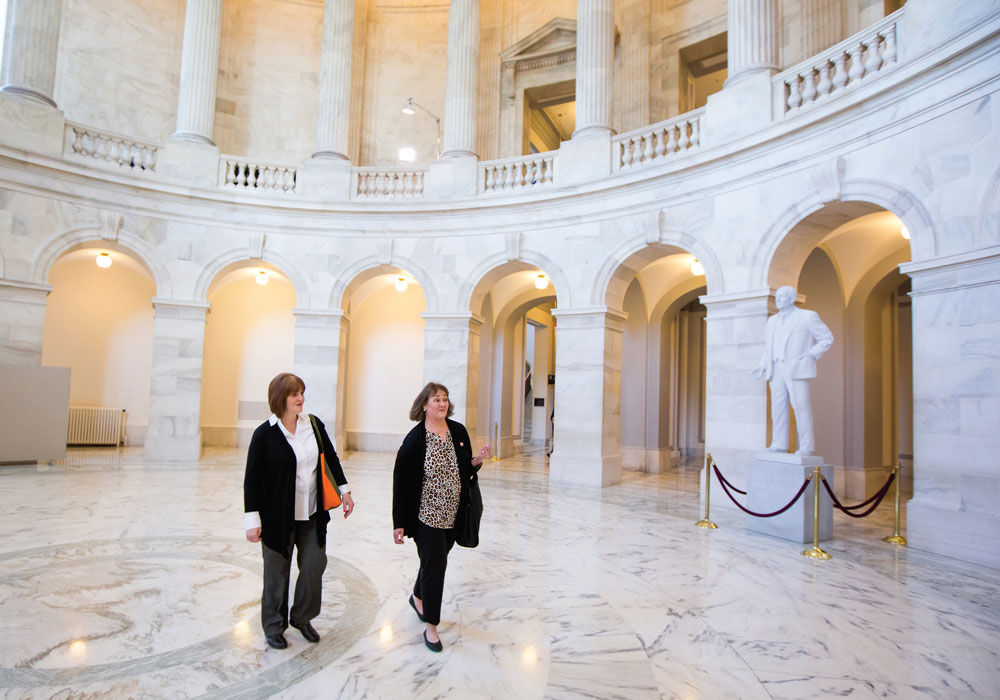Mastering the rules and regulations of democracy has been a capital city—both federal and state—game of power for more than 200 years. Those written, and too often presumed, procedures govern the process and provide a roadmap for legislators to strategize on how best to advance their agendas and campaign promises.
However, few could have imagined how a global pandemic would affect that routine. Typically slow to change, American government at all levels was stymied at the onset of the COVID-19 coronavirus as how to proceed with regular order—the manner through which a legislative body moves lawmaking forward.
How Government Adapted Processes Intended to Be in Person
The committee structure is designed to allow discussion and debate with the intent to find resolution on issue. Legislative bodies meet in person, have formally recognized public votes attributed to elected officials, and create laws. But because of COVID-19, traditional routines for gathering in meetings and interacting in close quarters were suspended, putting pending bills in limbo. Once the initial shock of the public health crisis was absorbed, what would Congress do about the country’s business at hand?
Although each U.S. Congress chamber operates independently with its own internal rules on process and decorum, the House of Representatives and the Senate must communicate and cooperate to ensure final passage of any bill. Currently, each has a majority from the opposing political party, adding to any institutional parameters for routine: the House has a Democrat majority and the Senate has a Republican. This means that although the House went out of session, closing formally, the Senate did not and maintained some standard operating procedures for continuity.
Policymaking at a Social Distance
Congress, and to a great degree state legislatures, had independent authority on how to combat the spreading virus and the host of issues that followed. Testing, equipment shortages, and when to reopen businesses were daily conversations and decision makers argued about how best to protect their citizens and find some semblance of normalcy. The public learned how the government would handle a national health crisis unlike anything it’s seen in 100 years.
Slow change was no longer a luxury, and Congress immediately passed legislation (e.g., Families First Act, Coronavirus Aid, Relief, and Economic Security Act [CARES] Act, Paycheck Protection Program) to bolster the economy and promote public health. It transitioned its committee meetings and usual public hearings to virtual settings, and even the U.S. Supreme Court heard cases by telephone for the first time in its history.
For Congress, the proxy voting it historically frowned upon was now embraced. Clarifying the shift from in-person voting, Speaker of the House Nancy Pelosi (D-CA) said. “The House voted to institute measures ensuring that Congress can continue to meet the needs of families and workers during the unprecedented challenge of the coronavirus, including with remove voting by proxy.”
How ONS Advocacy Responded
The ability to innovate and adapt in the wake of change is a hallmark trait of a nurse—and organizations run by nurses. ONS’s health policy priorities are to support evidence-based, coordinated-care proposals to enhance patient-centered health care. To ensure those were part of the ensuing bills, ONS joined the nursing community in successfully advocating for Title VIII nursing workforce legislation to be included in the CARES Act.
Additionally, ONS and the nursing advocacy community advanced support for National Institutes of Health research to speed discoveries and potential treatment for COVID-19. Finally, subsequent legislation providing nurses and other first responders with hazard pay, loan forgiveness, and funding for testing and tracing were included in the Heroes Act because of nurse advocacy efforts.
Is This the Future of Advocacy?
So begins a new era in legislating. The people’s business must continue because too much is at stake, but how that will evolve is still uncertain.
At 3.8 million strong, nursing is one of the largest professions in the United States. Leveraging that collective voice to promote an agenda that reflects nurses’ concerns requires activism. Make that oldest of rights literally count, and exercise yours with a vote this election.






